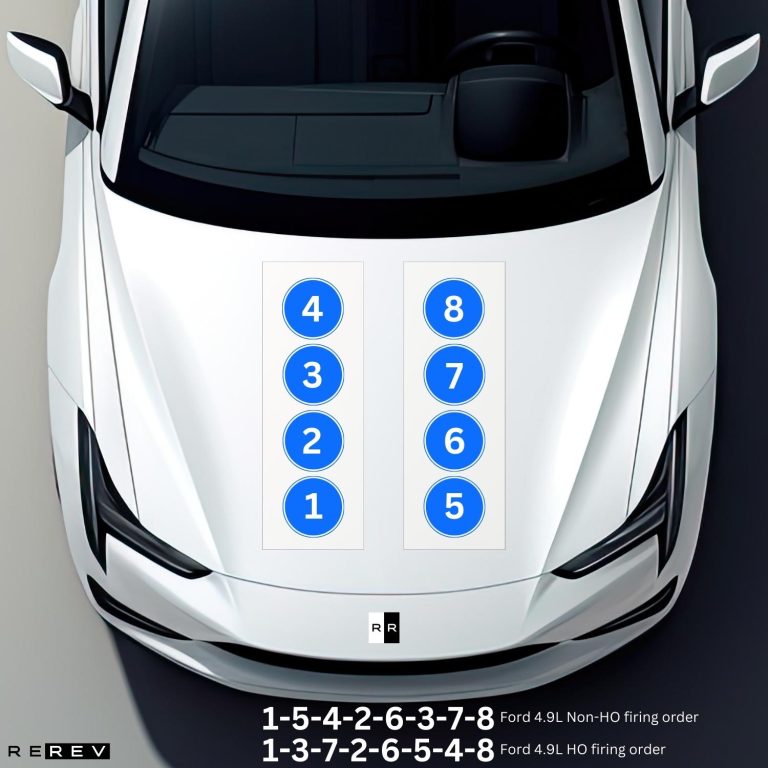Ford 4.9L (302 cu in) V8 firing order — diagram & guide
Essential configuration of the Ford 4.9L V8 engine's firing order.

Even though it was technically a 301.6 cubic inches engine, Ford always referred to its V8 4.9-liter engine as the famous “302”. The mark stayed one of Ford’s pinnacle engines for years, so it’s no wonder so many drivers inquire about the Ford 4.9L (302 cu in) firing order.
Well, the answer isn’t as simple as it seems, so let us guide you through the different variations of the famous 302 engine and discuss the firing sequence differences. After we go through the engine’s versions, their firing orders, and vehicle applications, you’ll be able to use that knowledge for the benefit of your ride.
Ford 4.9L “Non-HO” firing order
While there are two versions of the 302 engine, we first had to discuss the non-HO (non-high output) version as it came out first back in 1967. So, the Ford 4.9L non-HO firing order is 1-5-4-2-6-3-7-8 and this engine was in production up to 1982.
It’s a small block V8 which means shorter engine rods and a slightly different design of the pistons due to the size of the engine’s block.
This engine is also known as the “302 Windsor” as it was made in Ford’s Windsor factory, so you shouldn’t mistake it for an HO version that was later produced with a modern fuel-injection system. The regular 302 is a carburated engine, so even though it has the same displacement as the HO, the firing order is different.
Ford 4.9L HO firing order
Starting with the 1982 model year of the popular Ford models, the “HO” version of the 302 engine was introduced. The Ford 4.9L HO firing order is 1-3-7-2-6-5-4-8, and it’s quite different from the one we’ve already discussed.
This one is similar to the 351W and 302 Boss engine which was used in a 1970 Mustang with a higher power output derived from the same 302 engine we mentioned before.
So, the Boss Mustang is the only car that had a 302 engine in its original form and still didn’t feature the non-HO firing order. In case you own this particular car, make sure to consider the HO firing order for any repairs.
Ford 4.9L (302 cu in) cylinder diagram

The cylinder diagram for the 302 engine was pretty standard for Ford’s vehicles with a V8 engine at that time. So, we have Bank 1 (passenger’s side) with cylinders 1 to 4 and Bank 2 (driver’s side) with cylinders 5 to 8.
However, the firing order depends on the way that the plugs are connected to the distributor and it spins counter-clockwise to provide power to the plugs. So, that’s where the firing order comes in, and you can use the cylinder diagram along with the firing sequence for the necessary repairs.
Ford 4.9L vehicle applications
As a final step towards helping you fix your vehicle powered by a 302 engine, it’s time to go through the list of the common vehicles using this motor. We’ll also make sure to designate those that use the HO and those that use the regular one to help you apply the right firing order when doing the repairs:
- 1966-1970 Falcon (non-HO)
- 1966-1982 Mustang (non-HO)
- 1982-1995 Mustang (HO)
- 1970 “Boss” Mustang (HO)
- 1968-1982 LTD (non-HO)
- 1977-1993 Thunderbird (HO)
- 1971-1977 Maverick (non-HO)
- 1990-1995 Ford Explorer (HO)
Our take
Over the years, we’ve seen car owners struggle with the 4.9L 302 cu in firing order, especially when it comes to the Boss Mustang which uses a HO engine. So, we hope that this guide was able to clarify a bit what non-HO and HO variants of this engine mean.
We hope to have pointed out the firing order differences between these two, so you can use this article to help you replace the necessary components.